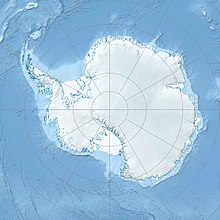Ellsworth Station
Coordinates: 77 ° 39 ′ 0 ″ S , 41 ° 2 ′ 0 ″ W.
The Ellsworth Station ( Spanish Estación Científica Ellsworth , English Ellsworth Scientific Station or Estación Ellsworth or Base Ellsworth for short ) was a permanent, year-round originally US American , later Argentine research station in Gould Bay on the Filchner-Ronne Ice Shelf . It was named after the American polar explorer Lincoln Ellsworth .
The station was abandoned in 1962, as progressive instability in the ice deteriorated the structure of the station's buildings and put personnel and equipment at risk.
history
Ellsworth Station was built by the United States Navy under the command of Captain Finn Ronne . The two icebreakers USS Staten Island and USS Wyandot of the United States Coast Guard were deployed under the command of Francis Gambacorta.
The originally planned location for the station was Cape Adams , but the terrain there proved to be unsuitable because of ice cliffs, which is why Gould Bay was chosen as an alternative. Gould Bay is on the west coast of the Weddell Sea on the Filchner-Ronne Ice Shelf, near the Argentinean Belgrano I station .
The order to build the station was placed on February 11, 1957 as part of the International Geophysical Year . Less than a year later, on January 17, 1959, the station was handed over to the Instituto Antártico Argentino (German Argentine Antarctic Institute ). As part of the handover, it was agreed that the US government would hand over the buildings, facilities and existing food and that Argentina would provide the logistical and administrative services for ongoing operations. Scientists from both countries should do research together in the station.
On December 31, 1959, the Argentine icebreaker ARA General San Martín, with exchange personnel and supplies to the station, intercepted a distress signal from the Norwegian - South African research vessel Polarbjorn that had got stuck in the ice. The General San Martín was able to free the ship, which was able to continue its way along the coastline. In the further course, however, she was no longer able to reach her original destination, which was located in the farthest point of the Weddell Sea , due to unusually thick pack ice.
On January 6, 1962, frigate captain Hermes Quijada of the Argentine naval aviators made a stopover at the station with two Douglas C-47s before flying on to the South Pole . This made him the first pilot to fly to the South Pole from the American continent.
Since the station was half sunken for most of the time due to unstable ice, the question of continued operation arose in the spring of 1962. To protect personnel and equipment, Ellsworth Station was evacuated on December 30, 1962 and finally closed in the Antarctic summer campaign 1962/1963. Argentine research teams inspected the station several times, in the end it was covered by snow and ice. The part of the Filchner-Ronne Ice Shelf on which the station stood eventually split off as a gigantic iceberg and drifted into the Southern Polar Sea , with the remains of the station finally being lost.
Scientific activities
The facilities at Ellstworth Station could accommodate over 40 people.
A number of experiments and observations were carried out during operation, including ionospheric observations with a riometry , biological and physiological observations, surface and atmospheric meteorology, including radiation and carbon dioxide concentration measurements.
There were also numerous expeditions for glaciological exploration of the Filchner-Ronne Ice Shelf, for which Ellsworth Station was the starting point. The most far-reaching reached the edge barrier of the ice shelf and made it possible to complete the triangulation between Ellsworth and Belgrano stations.
climate
The region lies in the path of northward moving weather fronts. Although they bring little precipitation, they cause strong winds of up to 200 km / h, which greatly reduce the perceived temperatures.
|
Average monthly temperatures and rainfall for Ellsworth Station
Source: Weatherbase
|
||||||||||||||||||||||||||||||||||||||||||||||||||||||||||||||||||||||||||||||||||||||||||||||||||||||||||||||||||||||||||||||||||||||||||||||||||||||
See also
Web links
- Fundaciòn Marambio - Base Ellsworth (Spanish)
- Dirección Nacional del Antártico
- Ellsworth Station , photos of the station from 1957 on coolantarctica.com (English)
Individual evidence
- ↑ a b c Campaña Antártica 1962–1963 ( Spanish ) Sitio no oficial del rompehielos ARA Almirante Irízar . Archived from the original on February 20, 2009.
- ↑ Tom Griffiths: Slicing the Silence: Voyaging to Antarctica . Harvard University Press, 2007, ISBN 978-0-674-02633-9 , p. 210.
- ↑ James L. Mooney: Dictionary of American Naval Fighting Ships . Government Printing Office, 1976, ISBN 978-0-16-002030-8 , p. 610.
- ↑ Antarctica Detail .
- ↑ James L. Mooney: Dictionary of American Naval Fighting Ships . Government Printing Office, 1976, ISBN 978-0-16-002030-8 , p. 610.
- ↑ a b c d e f g Base Ellsworth ( Spanish ) Fundaciòn Marambio. Archived from the original on March 24, 2014.
- ↑ : Papers and Proceedings . In: Symposium on Antarctic Logistics. National Academies, 1963.
- ↑ primer Vuelo Argentino al Polo Sur ( Spanish ) Fundaciòn Marambio. Archived from the original on March 3, 2011.
- ↑ Campaña Antártica 1972–1973 ( Spanish ) Sitio no oficial del rompehielos ARA Almirante Irízar . Archived from the original on March 24, 2014.
- ^ Base Belgrano II ( Spanish ) Fundaciòn Marambio. Archived from the original on June 2, 2012.
- ^ Weatherbase: Historical Weather for Ellsworth, Antarctica . Weatherbase. 2011. Retrieved November 24, 2011.
